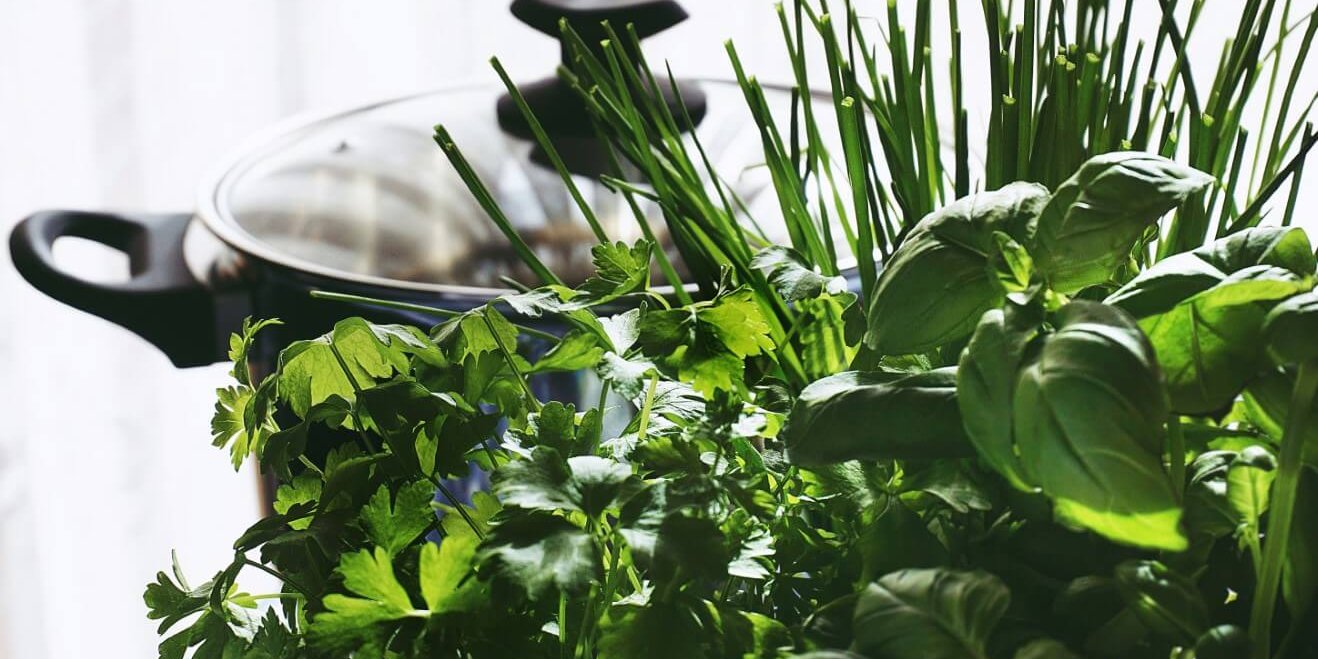If you have a glass jar and fresh water, you can grow herbs right on your windowsill! You can keep your jam jars or sauce jars for this. If you don’t have any, you can buy some cheap decorative glass jars.
You can start new herb plants by taking cuttings from existing plants and putting them in a container of plain water. The herbs will sprout roots that will draw up water and any available nutrients into the cuttings to create new plants.
Water bottles with a smaller lip than jars work very well. They keep the herb leaves from falling into the water.
Rooting herbs is very easy: take soft stem cuttings from healthy plants. Sometimes those little boxes or bunches at supermarkets can contain herbs which are sufficiently fresh and firm to use: the bonus is that you can use the herbs for cooking there and then while using the liveliest of the lot for cuttings. If possible, choose fresh young stems without flower parts. If there are flowers, remove them and remove the leaves from the bottom half of your stem cutting.
A rooting solution bought from local gardening shops can help with rooting the trickier herbs (such as rosemary). Put your cutting in a container of rooting solution for several hours. Submerge the stripped part and keep the leaves out of the water. Use of the rooting solution is optional.
Fill the jar with tepid water. A clear glass container makes it easy to check on rooting.
Place your jar on a sunny windowsill or another warm, well-lit place.
Change the water every few days. Use room temperature water for rooting—hot water can kill the plant, and cold water will slow down the growth and development of roots.
You should begin to see tiny white roots emerge from the submerged stems within one or two weeks.
Many cuttings will last for a few months. Some just a few weeks. Either way, it is a convenient way to keep herbs at the ready in your kitchen for your next meal.
1. Mint
Grow mint in a jar and snip off a bit to make herbal tea, oil or soup. You can also just enjoy the sweet scent of this fragrant herb. Mint does well in partially sunny or shady windows.
2. Oregano
You can use fresh oregano straight in pasta sauces, soups and other savoury dishes. Gently remove a few leaves from the stem using a pair of kitchen scissors. Oregano can grow quite large, so keep an eye on your plant.
3. Sage
Sage has a flavourful scent, which makes it a popular choice. Snip as much as you need and add it to your favourite dish. Sage does not need a lot of water Keep sage in moderate sunlight.
4. Basil
This popular Italian herb, used in many popular dishes, sauces and soups grows well in water. Make sure your basil jar gets about 6 to 8 hours of sunlight per day.
5. Thyme
Thyme is a versatile herb. It will flower, and the flowers are edible. You can also harvest it before it flowers, hang the stems to dry the leaves and then remove the leaves to use in cooking. Thyme needs plenty of sunlight, so set those jars in a bright window.
6. Rosemary
This flavourful herb does well in sunlight or partially shaded areas. It will grow better in full sunlight though. Use your rosemary to spice up your favourite chicken dish!
7. Chives
This onion family member is super easy to grow, and you can use it in lots of dishes. Make sure this herb has plenty of water and sunlight for best growth results.
8. Coriander
Coriander or as it is known in USA, cilantro thrives in sunlight but also in partial shade too. Use this flavourful herb to add an extra punch to your salsa and other Mexican-inspired dishes as well as Thai or Vietnamese dishes.
9. Marjoram
This herb does really well indoors, but grows best in full sunlight. It is a bit slower to grow, so you may need a little patience. Use it to spice chicken and beef dishes.
Article by Peter Miceli Saydon – Ġemma Team



